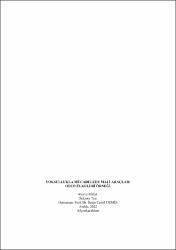| dc.contributor.advisor | Demir, İhsan Cemil | |
| dc.contributor.author | Malak, Merve | |
| dc.date.accessioned | 2023-01-09T06:58:12Z | |
| dc.date.available | 2023-01-09T06:58:12Z | |
| dc.date.issued | 2022 | en_US |
| dc.date.submitted | 2022 | |
| dc.identifier.uri | https://hdl.handle.net/11630/10245 | |
| dc.description.abstract | Devletin yoksulluk sorunu ile mücadelede kullanacağı araçların başında kamu harcamaları ve kamu gelirleri gibi mali araçlar gelmektedir. Bu çalışmanın amacı mali araçların yoksulluk üzerindeki etkisini incelenmektir. Çalışma 24 OECD ülkesi ile 2004-2017 yılları arası veri setini kapsamaktadır. Çalışmada yöntem olarak panel veri analizi kullanılmış ve tüm modeller sabit etkiler modeli ile tahmin edilmiştir. Yoksulluğu etkileyen faktörler ekonomik büyüme, GINI, kişi başı gelir, enflasyon ve işsizlik değişkenleridir. Mali araç değişkenleri olarak ise kamu harcamaları, kamu gelirleri ve kamu borcu değişkenleri kullanılmıştır. Analiz sonuçlarına göre, mali araçlar ile yoksulluk oranı arasında bir ilişki olduğu kabul edilmiştir. Buna göre, cari, sağlık ve sosyal kamu harcamaları, kurumlar vergisi ve ÖTV ile yoksulluk oranı arasındaki ilişki negatiftir. Buna karşılık kamu borçlanması ile yoksulluk oranı arasındaki ilişki pozitiftir. Kamu harcamalarının yoksulluk oranı üzerindeki negatif etki, kamu gelirlerine kıyasla daha baskındır. Kamu borç yükünün artması yoksulluk oranını artırmaktadır. Bu bulgulara göre yoksulluk oranı ile mali araçlar arasında yakın bir ilişki bulunmaktadır. Yoksulluk ile mücadele politikalarında, etkin olan mali araçların kullanımına ağırlık verilerek yoksulluk sorunu üzerinde iyileşme sağlanabilecektir. | en_US |
| dc.description.abstract | Fiscal policy instruments such as public expenditures and public revenues are at the forefront of the governments’ tools in poverty reduction. Considering these, this study aims to examine the effect of public tools on poverty. The study covers the data set of the 24 OECD countries between 2004 and 2017. The panel data analysis is used as a method in the study, and all models were estimated with a fixed-effects model. The factors affecting poverty were economic growth, GINI, per capita income, inflation, and unemployment. Public expenditures, public revenues, and public deb are used as public instruments variables. The results showed a relationship between public instruments and the poverty rate. In other words, the poverty rate is negatively relationship with public consumption, health expenditures, social expenditures, corporate tax, and excise tax. On the contrary to this finding, there is a positive relationship between public debt and poverty rate. The negative effect of public expenditures on the poverty rate is more effective than public revenues. The increases in public debt burden also increases the poverty rate. To sum up, there is a close relationship between the poverty rate and public instruments. An improvement can be achieved on the problem of poverty by emphasize on the use of effective public instruments in the policies of poverty reduction. | en_US |
| dc.language.iso | tur | en_US |
| dc.publisher | Afyon Kocatepe Üniversitesi Sosyal Bilimler Enstitüsü | en_US |
| dc.rights | info:eu-repo/semantics/openAccess | en_US |
| dc.subject | Yoksulluk | en_US |
| dc.subject | Kamu Harcaması | en_US |
| dc.subject | Kamu Gelirleri | en_US |
| dc.subject | Kamu Borçlanması | en_US |
| dc.title | Yoksullukla mücadelede mali araçlar: OECD ülkeleri örneği | en_US |
| dc.title.alternative | Public instruments for poverty reduction: The case of oecd countries | en_US |
| dc.type | doctoralThesis | en_US |
| dc.department | Enstitüler, Sosyal Bilimler Enstitüsü, Maliye Ana Bilim Dalı | en_US |
| dc.relation.publicationcategory | Tez | en_US |
| dc.contributor.institutionauthor | Malak, Merve | |



















